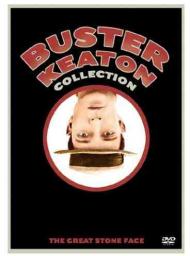Movie Review
The High Sign
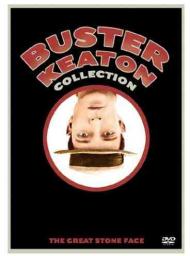
US Release Date: 04-18-1921
Directed by: Buster Keaton
Starring▸▾
- Buster Keaton, as
- Our Hero
- Bartine Burkett, as
- Miss Nickelnurser
- Charles Dorety, as
- Gang member
- Joe Roberts, as
- Leader of Buzzards
- Al St. John as
- Man on beach
![2.75 star[s] out of 4](http://www.threemoviebuffs.com/static/images/global/featured_gold_stars.png)
![3 star[s] out of 4](http://www.threemoviebuffs.com/static/images/global/featured_gold_stars.png)
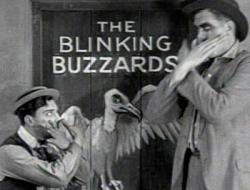
Buster Keaton learning the high sign from Joe Roberts.
Buster Keaton's last film with Fatty Arbuckle was The Garage, released in January, 1920. As that movie was in theaters, Keaton was busy at work on his first independent film, The High Sign. He was a bit apprehensive about the results. He shelved the film and started work on One Week. In 1921 he broke his ankle and could not work, so he finally released The High Sign.
I am not sure why Keaton was so nervous about this movie. It seemed he edited it greatly. A search of images on the web find stills from scenes that are no longer in the film. Although not his greatest work, it is certainly not his worst. He worked with Edward Cline, who would collaborate with Keaton on many of his films. He also employed Arbuckle's nephew, Al St John, who had worked with Keaton in many Arbuckle shorts.
The film opens with Buster being thrown off a train. He gets a job in a shooting gallery run by the leader of a gang called the Blinking Buzzards. Keaton gets forced into the gang and is instructed to kill a local businessman named Nickelnurser. That same day, Nickelnurser and his daughter come into the shooting gallery, and being impressed with Keaton's supposed marksmanship, hire him to be his bodyguard. Thus Keaton is supposed to kill the man who just hired him for protection.
Everyone ends up at Nickelnurser's home. He has installed secret doors in every room as a means of escape. Keaton takes advantage of them all as he does battle with the Blinking Buzzard gang. It starts showing Keaton being chased in individual rooms, but then the camera pulls back and shows all four rooms as a life size doll house with Keaton racing around through secret doors.
The High Sign has some great visuals. One surreal moment has Keaton paint a hook on the wall and then hang his hat on it. Another funny bit is Keaton trying to read a newspaper. He keeps unfolding it until it is larger than a blanket.
No doubt Keaton wanted to start his solo career out with a bang, and felt this was not the film to do it with. One Week became his first solo release and it is one of his best. The High Sign is only a slighter less effort, but works better as his first solo film. The opening shot of Keaton getting off the train is symbolic of him starting over and a sign of things to come, The General.
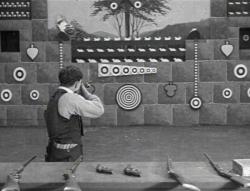
Our Hero takes aim in The High Sign.
One Week is a vastly superior movie. It is arguably Keaton’s best two-reeler. The High Sign falls short in terms of laughs. It doesn’t contain that many. I chuckled at the oversized newspaper that Keaton kept unfolding, but many of the gags have a been-there done-that feel to them. There is even a banana peel on the sidewalk in one scene.
The funniest single moment comes right after Buster joins the Blinking Buzzards when Joe Roberts opens the door to the shooting gallery and sends Keaton flying over a low counter. Keaton sits dazed on the floor for a second and then comically makes the gangs titular hand sign before collapsing on his side. Once again proving that no one - and I mean no one - could take a pratfall like Buster Keaton.
Keaton always made good use of props. More than any other silent comic he employed specially designed sets. In many of his movies the house or houses feature secret doorways or specifically created elements. The best part of this movie is the final few minutes at August Nickelnurser’s house. (The funniest title card is a death threat sent to Nickelnurser by the Blinking Buzzard gang. It says that if he doesn’t pay them 10,000 dollars by the first of September it will be the end of August.)
When the camera pulls back and reveals the different rooms like a doll house it is a very clever bit of filmmaking. It’s too bad that Keaton utilizes this bit for only 3 or 4 minutes at the very end of the movie. Keaton made the right decision in releasing One Week as his first solo effort. It is a brilliant movie whereas The High Sign is just an average one.
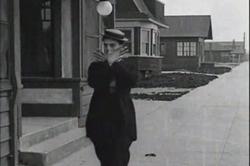
Buster Keaton gives The High Sign.
Patrick, you sell this two-reeler short. Like Eric, I'm not sure why Keaton was so nervous about it. Maybe he thought it was more similar to his work with Arbuckle than One Week was and so wanted something that would differentiate himself from his earlier work. Or maybe he just needed to build up his confidence more, but either way, he needn't have worried as this short is quite funny.
The big sight-gag of the picture is obviously the four room "dollhouse" set and it is brilliantly done. Keaton throws himself around it with seemingly boundless energy and never appears out of breath despite being a smoker! His antics are like that of a cartoon character and you can see echoes of him in the later Warner Bros. cartoons.
There's lots to laugh at before that finale though. Keaton's prowess with the gun and the customers methods of cheating are all worth a laugh, especially when one of them immediately uses the gun to rob Keaton instead of shoot. Can you imagine a shooting range today using real guns?
Although silent movies had to rely on physical humor for obvious reasons, I'm always amused by the number of verbal jokes that are snuck in either on the title cards or in other clever ways. Here the miser is named Nickelnurser and the title card describing the Buzzards is written alliteratively. It's a sight gag, but another surreal moment of humor I enjoyed is when Keaton looks into his coffee cup after its been spiked and literally sees that it's got "kick".
Maybe overall this short isn't on the same level as One Week, but it's much better than average.
Photos © Copyright Joseph M. Schenck Productions (1921)

